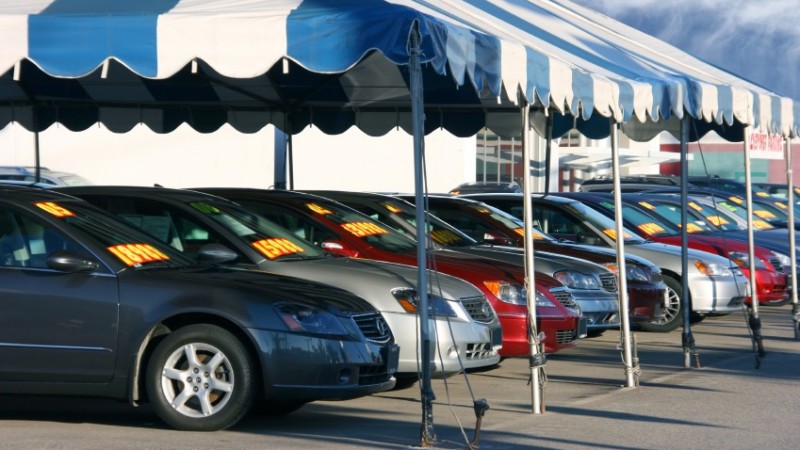Car Buying Guide
Introduction
Listen to the hype—whether it's on TV, online, or in print—and you'd think saving money on a vehicle is as easy and fast as flipping the TV remote. Wrong! Did you know a dealer or online auto service can sell or lease you a new set of wheels for exactly what the dealer paid the manufacturer and still make $500 to $1,500 on just the car itself?
Car buying guide introduction video.
Did you know that "Zero Percent" financing may cost you more than financing at a bank or credit union—even if the bank or credit union's rate is 7 percent?
Do you hate dealing with dealers and look forward to buying or leasing a vehicle online—or from a buying service—just so you won't have to deal with the dealer yourself? Guess what: you have to deal with a dealer, even if you use a buying service! All new vehicle sales—repeat, all—have to involve a dealer.
Car Buying Websites
Do you think the Internet has made it safer for you to research and/or acquire a new vehicle? Think again! In just the past three years, the entire auto business has been ripped apart, reinvented, and re-launched. "In an instant, your privacy, your money, and your good credit can be stripped away—and that's if you're dealing with the 'good' car guys!"
That quote, from the latest edition of my book Don't Get Taken Every Time, sums it up. (Read the Introduction and Chapter 1 of the book.)
Straight Answers
"Just click here and this beautiful convertible can be yours for $1 under invoice. Unbelievable! And we've got Zero Percent financing. Even more unbelievable! And we'll give you a free computer when you buy from us! And we guarantee the value of your trade-in!"
~ Guy on the TV Commercial
Why this car buying guide is different? Because it frankly tells you the truth. I've written this special buying guide for you to give you straight answers about the car buying and leasing process.
For over 30 years, I've tracked the inner workings of the auto industry. As President and co-founder of the non-profit Consumer Task Force For Automotive Issues, and as co-founder of the Privacy Rights Now Coalition, I've pretty much seen it all when it comes to wacky sales gimmicks, deception and consumer abuse. And, it's my sworn duty to keep those things from happening to you!
And will this guide work! If you follow this guide, you can probably keep thousands of your hard-earned dollars in your pocket rather than in the dealer's.
A major promise up-front: FoolProof is about educating you, not trying to hype you. This program provides you an oasis from the pressure, confusion and deception that is rampant in the auto industry and on the Web. And it gives you straight answers.
For instance, where is it cheapest to finance? If Directions Credit Union determines that it would be cheaper and better for you to finance at some other institution, they'll tell you. Think about that! Do you really think any other financial institution would do that?
Directions Credit Union makes that promise because their goals are different than the other players in the auto industry. A dealer or their finance sources have two objectives: to sell you their product or service (whether or not it's the right product for you) and to sell it to you at the maximum price you will pay. BayPort's job, on the other hand, is to make sure you buy what's best for you and to make sure you pay the least for it.
They're not just being noble, either. Since you own part of the credit union, Directions Credit Union's financial well-being is linked closely to your financial well-being: when you prosper financially, they prosper.
And since Directions Credit Union is not-for-profit and owned by you, their prosperity translates into money and benefits for you. Nice!
Any questions? Why not contact us? And thanks for reading. Your pocketbook, as they say, will thank you.

Chapter 1. Dealership Tactics
What's Really Happening Down at the Dealership?
To win in any auto transaction, you first have to understand what the other side is trying to do to you, and why. Since "the other side" always includes a physical automobile dealership—even if you're buying or leasing from an online service—I'm going to take you inside a typical dealership right now. What's really going on down there?

The pressure game starts before you go near a dealership, either online or in person. Just look at the dealer ads: they promise low payments, sales, big money for your trade and respect for your intellect. But, as with most selling, these promises come with some crossed fingers. Did you know that many dealers make more during sales than they do at non-sale time? That's because we consumers automatically equate the word "sale" with "save." That's dangerous math. Dealer advertising really has another purpose: To get you to rush down in a fit of excitement ("Really? Just $99 a month?!") without stopping to think.
The "Track" System Takes Over
A "track" system is an automobile sales program designed to put every customer through the exact same sales steps with the sole intent of selling that customer instantly for the maximum profit. The key words here are "instantly" and "maximum profit." When you arrive at a dealership (or log-on to most auto websites) the dealership begins to "work" you: put you through the track system.
The objective is always the same: Get you to pay more for every item and service than you were planning to pay. Want to spend $450 a month? A savvy dealership will get you to pay $550. Or they will happily sell you a car for $450 per month—but it will be a car you could have bought for $350 per month. Nice of them.
The car dealership is concerned about its profit, not your budget.
The people at virtually any dealership and most websites and buying services, friendly though they may be, have a little different objective in the car transaction than you do. Their goal is always to maximize profit. And that might mean leaving out an important fact or two.
To take one example, what would you do if you owned a dealership that sold cars ranked lowest on the government crash safety reports? Would you tell all your customers: "Oh, don't forget—our cars are the most dangerous on the road!"
See the problem? To survive, the dealership must either lie about the dangerous test results, or simply forget to talk about the results.
What's the Outcome of This?
The sellers of automobiles generally can't give you good advice about what you should spend, number one. No salesperson in the auto industry ever prospered by volunteering to cut the price on every sale or always telling the whole truth about its vehicles.
Number two, the sellers of a particular automobile generally can't give you the answers you need to questions about such matters as a car's safety, reliability or resale value.
But these questions are important, aren't they? And you'll need the answers before you even look in the direction of the dealership.
Why? Because once you're engaged with these folks, the "track system" will take over and speed you along recklessly whether you like it or not.
Car Dealership Tactics
Here's a look at a few of the tactics track systems use to "work" you.

You stop into the dealership simply to pick up a brochure. Even though you have no intention of buying, the smiling salesperson requests your driver's license, your Social Security number or simply your address. Or maybe they want to register you for a fabulous free trip to Paris.
Even though you haven't given permission, many dealerships will now search their databases and quickly open a file on you. And because many dealerships are now owned by conglomerates that already have information on you, the dealership has an informal "read" on your credit without even pulling a credit report!
With that informal "read," the dealership then begins to plan the maximum profit they can make on you, based upon your credit worthiness. And you really only stopped into the dealership to use their restroom.
More Tactics
-
The Dealership T.O.s You
"T.O." stands for "turn over." You're sitting in a salesperson's office, thinking about how much more fun it would be to change the oil in your car in the dark rather than go through this, when your salesperson returns with reinforcement— another person. The new smiling face asks for more money. And then the salesperson asks for more. The T. O. system operates on the principle of "fresh faces can work miracles." A miracle, in this instance, is defined as more profit. And as long as you keep giving, they'll keep asking. -
The "Note" System
Rather than "T.O.ing" you, some dealerships use the note system: The salesperson steps out, returning with a nice note from the sales manager asking for more money. And then another note, then another. Usually, the salesperson comes back with five notes, and usually the last two ask for raises of odd amounts of money—for instance, $113.29 or, finally, $23.19. The note system has one basic problem. It makes you think the dealership is negotiating when it's really only play-acting. Consider the "odd" raises. These are simply designed to make it look like you're really a hard bargainer. You know, you think you've got them "down to the pennies."A tip: Many Web-based sellers use versions of the note system.
-
The Four Square System
The salesperson divides a piece of paper into four squares and then asks for your "wish list." What do you want to pay a month? What do you want for your trade? What do you want to pay for the new car? However ridiculous the sums, each are written in a square. Then they ask for a large deposit, and then they ask for your signature in the fourth square.Daily the methods used by many dealerships and online selling organizations grow more sophisticated and subtle.
Then they begin to "work" you on each square separately. You wanted to pay $20,000 for the car? They ask for $40,000! Very slowly the salesperson negotiates down, constantly scratching through figures. By the time they finish, the paper is illegible, you're frazzled, but the salesperson is smiling. You've agreed to pay an additional $1,200 to $1,500 profit.
The four square system is probably the worst system in use today because it was designed solely to confuse you and produce some very nice profits. Don't deal with dealerships that use this system.
-
Spot Delivery, or "Yo-Yo" Selling
"You can drive it off today!" That is the most expensive statement any car dealer or Web seller can make. Spot delivery means emotion is ruling you rather than good sense. It also means you (very conveniently for the seller) won't have the opportunity to compare costs and terms.The real danger in Spot Delivery: Spot Delivery has become a fraudulent selling technique at many dealerships. These dealerships deliver you a car on any terms you want. Then a few days after you've taken delivery, they call you up and say "Oops, your contract wasn't approved at the figures you wanted. We need an extra $1,000 in cash, your payment has gone up $300 per month and we've added 12 more payments!"
What can you do if that happens? Usually nothing. They've already sold your trade-in, and you unknowingly signed an agreement to let the dealer raise the price! This type of Spot Delivery is called "yo-yo selling" by unethical dealerships, and is endemic in the auto business. It is also the subject of hundreds of lawsuits at this very moment.
How do you protect yourself from spot delivery? Never buy or take delivery of a car on your first visit to a dealership or a website.
A FoolProof tip: By financing with Directions Credit Union, you are totally protected from yo-yo selling.
-
The "Business Advisor" or "Financial Counselor" Scam
Even if you have the cash in your pocket to pay for a vehicle, you'll be forced to talk with a dealership's finance sales staff. Or, as they are quaintly called at some dealerships, "Business Advisors" or "Financial Counselors." Why do these high-pressure finance salespersons insist on talking with you? Because dealerships make much more money on financing these days than they normally make on the sale of an actual vehicle. Many dealerships will do almost anything to convert you to their financing, including shading the truth a bit.And if the dealership can convert you to their financing, they'll sell you credit life and credit disability insurance that's almost always more expensive than a credit union's or a bank's but sounds downright cheap on a "pennies per month" basis. Then they'll sell you "protection" packages (rust proofing, undercoating, fabric conditioning) "for just $19 per month."
Why, you can afford that! But over 60 months, you will pay over $1,140 for products that cost the dealer $100. The same approach works for extended warranties or mechanical breakdown insurance, too.
Daily the methods used by many dealerships and online selling organizations grow more sophisticated and subtle. For instance, many dealerships now track customers' movements by computer, rate their moods on scales entered in computers, and flash their progress in the buying process on computer screens so managers and other salespeople can monitor the dealerships' careful plan to sell.
How Can You Avoid These Traps?
Buying a car isn't one negotiation, it's many: your trade, the new car you're buying, the financing—and the newest, most popular profit centers—warranties, protection packages, alarm systems and other add-ons.
If you don't know what you're doing, you can save money in one area and pay too much in the other; no fun at all. That's why dealers can sell cars for "no profit" and still make thousands on you. And that's why you need to pay very close attention to the right steps.
Chapter 2. Buying a Vehicle
Many Negotiations, Not One

If you really want to save money and still like your car after the fourth payment, you'll have to look at the car-buying transaction in a new way. Most people find a car and adjust their budget to fit that car's payment. That's the wrong way, and usually means you end up eating pinto beans for years on end.
The Right Way, Step-by-Step
The FoolProof approach doesn't start with the car at all; it starts with your budget. We encourage you to slow down rather than speed up. Emotions in car buying should come after you've done it right.
And we define "right" as saving money and buying the right car, too. Doing it our way, versus simply following the dealership's lead, can literally put thousands in your pocket.
So, throw out the conventional thinking and consider this:
- All cars are bought for cash.
- No cars are bought with trade-ins or payments.
- Trade-ins and payments only provide you cash.
Right now, based upon your budget and your old car, you have an exact amount of cash available to you to buy a new car. That amount of money is called "Available Cash," and it's—logically enough—made up of all the cash you have available to buy a car.
"Available Cash" is made up of three things:
- The cash your payment will buy you, called "Loan Cash."
- Any cash your trade-in may give you after paying off your current loan. That cash is called "equity."
- Any other cash you may have—rebate money or savings, for instance.
Know your Available Cash figure and you'll always be on budget.
Understanding "Available Cash"
Understanding "Available Cash" helps you understand your budget.
Here's an example of "Available Cash."
You say:
- "I take home $2,500 per month after taxes and deductions.
- I drive a three year-old Mustang convertible.
- I owe $13,000 on it.
- I want to trade in my car.
- I don't want to make more than 48 payments.
- Now, what can I afford to buy?"
You plug all that information into the Available Cash calculator and you'll get this answer: "Okay, according to all that information, what you really said was, 'Based on my budget and my trade-in, I have $26,000 in Available Cash to buy a vehicle.'"
Know your Available Cash figure and you'll always be on budget.
What's Your Personal Available Cash Figure?
That's easy to determine. Use the calculator in the right hand column after you complete the following steps (You can use our Available Cash Worksheet).
Calculate Available Cash
Your Available Cash is the maximum amount you have to spend on a vehicle. This calculator enables you to determine:
The amount of cash a vehicle loan will yield.
The total Available Cash from all sources, including the loan, you have to purchase the vehicle.
If the estimated amount of Available Cash is too little for the vehicle you would like to purchase, you have several options. A higher monthly payment and/or a longer loan term will typically yield higher initial Loan Cash, thus increasing your Available Cash. You may also want to consider alternative vehicles that better fit your budget.
To estimate the value of your trade, visit the Edmunds website.
Current rates and terms for Directions Credit Union's vehicle loans are available on our rates page.
Use these steps to figure your Available Cash:
-
Determine a "Wholesale" Value for Your Trade-in
"Wholesale" is the amount of money a dealer will pay for your old vehicle. But "wholesale" isn't a definite figure, the amount can vary from dealer to dealer. At most dealerships the objective, incidentally, is virtually always to give you as little for your old vehicle as possible.If you are very smart, you need to determine your individual vehicle's wholesale value. Here are three ways:
-
A good way: Clean up your trade and drive it to three or four used-car departments of new-car dealerships, and tell the manager you are thinking about selling your old car, not trading it. The highest offer a dealer makes to buy your car is its true wholesale value.
-
A quick but less accurate way: Go to www.nadaguides.com and look up your current vehicle. This figure isn't exact—it's an average for all cars in a specific category, so use it only as a guide.
Caution: NADA Guides is a commercial site used by many dealers and others in the business to solicit your business. So, be cautious as you use this site, ignore all the ads and come back to FoolProof.
-
What if you still owe money on your trade-in? If you still owe money on your current vehicle, you will need to know its "pay-off" to figure how much "equity"— cash value—the vehicle is worth. For a rough estimate of the amount owed, multiply your payment figure by the remaining months in the loan. Subtract that figure from the vehicle's wholesale value to determine a conservative estimate of the vehicle's equity. For a more accurate figure, call your financing institution and ask for the pay-off (or "loan balance") amount. You'll need your loan account number to get that. Write your pay-off and equity on your Available Cash Worksheet.
-
-
What Can You Really Afford to Pay Each Month on a Vehicle?
Do you want to pay more than you're paying now? Would it make your life easier if you had a lower payment? You decide. Once you decide what would be a sensible payment for you, write the figure on your worksheet:-
I want to pay _____ dollars per month.
-
-
How Many Months Should You Finance?
Finance for the fewest months, not the most months. Some lending institutions will finance you for 8 or 10 years. But the truth is, you're making a big mistake if you finance a car for more than 5 years—and you would be smart if you didn't finance more than three years. Financing longer means you're paying vastly more money in interest, and virtually always guarantees that you will owe more money on your vehicle than it is worth. If it falls apart, you're still going to be forced to make payments on it.And get this nice benefit of financing for less months: By financing for the fewest months that will fit your budget you actually can buy more vehicle. For instance, the difference on a $30,000 loan financed for 48 instead of 60 months is only $4 a day. Pay the higher payment, finance for 48 months rather than 60, and you'll save over $2,000 in interest. Great! You're already saving money. And wouldn't it be nice not to have car payments for that fifth year? So how many months should you go? Jot that number on your Available Cash Worksheet:
-
I want to make $____ payments for ___ months.
-
-
How Much Other Cash Do You Have on Hand That You Plan to Spend on a New Vehicle?
Are you looking at a car with a rebate? Include that figure here. Do you have savings that you plan to use as additional down payment? Include that figure.
Now, let's use the facts on your worksheet to determine your Available Cash using the Available Cash Calculator in the right hand column.
When you finish, congratulate yourself. Your Available Cash figure rules! To stay within your budget, Available Cash is all the money you've got in your car buying account. That's all the money you have to pay for everything: cost of car, taxes, other charges, insurance, etc. Exceeding your Available Cash is like bouncing a check on your budget. And you know you don't want to do that.
Chapter 3. Research Before Buying
Save your emotions for the moment you finally drive away on budget in your shiny car with an extra thousand or two in your pocket.
Put Your Emotions Aside
Don't go near that dealership! Once you know how much Available Cash you have, get the hard facts about the vehicles that fit your Available Cashfigure before you go any further. For instance:
- What vehicles fit your budget?
- What do these cars cost the dealers?
- What are the vehicles' safety records?
- What about mechanical reliability and maintenance costs?
- What about insurance costs?
- What about operating costs, such as fuel economy?
Resources for Research

The following resources available online can help you find the information you need to choose wisely. Please remember that these are third-party sites that FoolProof doesn't control. These are sites, however, that I have found provide generally sound, helpful information.
-
Consumer Reports generally gives excellent, objective information on safety and reliability. You can research copies at the library, or visit www.consumerreports.org. Consumer Reports charges $7.95 per month (or $35 per year) to access their online articles, but it's worth every penny.
-
The Center For Auto Safety, provides free information on reliability, maintenance and safety issues. This is one of the most important sites on the Web, so bookmark it, then click on "auto defects" in the top tabs.
-
The National Highway Traffic Safety Administration has a dynamic site to help you research safety and dependability. Research government crash test results and safety recalls
-
The Insurance Institute for Highway Safety provides results for its crash tests.
-
Find out the fuel economy rating on any vehicle at www.fueleconomy.org, a service of the Environmental Protection Agency (EPA).
-
How much will insurance cost for that vehicle you are considering? Rates can vary considerably between two similar models as well as between insurance companies for the same model. Check out Consumer Reports' guide to car insurance.
Manufacturers' "Consumer" Sites
The manufacturers all offer "consumer" sites which supposedly tell you objective information about their vehicles. Frankly, these sites are nearly worthless when it comes to learning anything negative about a vehicle. If a manufacturer's most popular car is having serious problems with its airbags, you're not going to read about that problem first on the manufacturer's site.
Big tip: Do not rely upon manufacturer (or dealer) websites when you are making decisions on safety, reliability, or resale value. The sites can be fun to visit, regardless. Most now offer "virtual" tours of individual vehicles. Just use your search engine and any manufacturer's name.
Did you know some dealers and online lenders charge you thousands more in interest to finance a used car than they would to finance the same amount on a new car?
Now It's Time to Shop for the One Vehicle You Like!
Like a chocoholic's first whiff of a candy factory, your first visit to a dealership or website poses the maximum danger to your pocketbook. Those new or newer cars look so good. And you've waited so long. Whether online or in person, sellers know how to turn up the fires of your enthusiasm and singe your reason.
So put your emotions aside. Be wary. Slow down. Save the emotions for the moment you finally drive away on budget in your shiny car with an extra thousand or two in your pocket. Now that's something to get excited about!
Big FoolProof tip: For decades, I've told people that buying the right used car is one of the smartest things you can do.
New cars are the worst investment in the world. They depreciate in seconds, thousands of dollars, the minute you drive off the lot.
But buying used can be the worst thing many people do, because they don't understand the specific problems used-car buyers face, on the Web or at a dealership. For instance, did you know some dealers and online lenders charge you thousands more in interest to finance a used car than they would to finance the same amount on a new car?
How do you stop that from happening to you? Keep reading. We've got a special "Buying a Used Vehicle" section for you, and the information is priceless. But first, let's deal with new vehicles.
Chapter 4. Buying a New Vehicle
Ready to Match Wits with the Dealership?

Good! You can match wits and win. Just keep reading.
Simple Rules to Remember:
-
Narrow Your Choice
Narrow your choice to one or two models or makes before setting foot on a car lot. Why? Trying to think about a big list will do nothing but confuse you.Be aware during your first dealership visit: You are under the microscope at a dealership. Many dealerships already have you in a database. Most are anxious to pull a current credit report on you. All want to use information about you to maximize their chances to make a big profit. Don't let that happen! Unless you definitely plan to finance at the car dealership, don't allow any dealership to pull a credit report on you at this stage.
For instance, many dealerships will ask for a copy of your driver's license before they will let you test drive a vehicle. A dealership has a right to know if you have a valid license. But you don't have to allow them to request a credit report at this stage. How to stop this? Say up front, "I do not authorize you to pull a credit report on me."
-
Choose Two Nearby Dealerships
Now, choose two nearby dealerships that stock the vehicle you like. If you've done your homework, where you buy isn't important as long as the dealership is reputable. -
Find Only One Car at Each Dealership
You can't buy three cars. Keep it simple: Find the one you like the best. -
Take Control of the Transaction
Tell the salesperson you are not buying a car today under any circumstances, but you will buy soon. Today you are just shopping and fact-finding. Check the car out. Take a test drive. But be firm and don't let the salesperson lead you into any discussion of buying today. If you start to feel pressure or confusion leave immediately. -
Copy the Information from the Manufacturer's Suggested Retail Price Sticker
Copy all the information from the Manufacturer's Suggested Retail price sticker before leaving the dealership (MSRP, not the dealer's sticker). The MSRP is the sticker with the lowest price on the vehicle's window. Copy all the dollar information from that sticker. For instance, the vehicle's base price, then the name and price of options. (Use our "Auto Shopping Worksheet.") For now, ignore the dealer's sticker, which is always higher than the Manufacturer's sticker. The dealer sticker contains hugely inflated profits. -
Compute the Dealer's Invoice Cost
A very important step. Use one of the online price guides below to calculate this amount. Some credit unions and banks can also help you determine dealer cost. Some dealers also say they will tell you dealer cost, but I would not rely upon their figures. Why is knowing the dealer's invoice cost so important? Dealers want you to negotiate down from their inflated asking price, a very expensive way to negotiate. The FoolProof approach negotiates up from what a dealer paid for the one car you like. Don't ever think percentage discounts from dealer asking prices; don't ever think "sale" price. Know what the dealer paid for the car you like and negotiate up from that. Here are two links to two of these invoice-pricing services Edmunds.com or nadaguides.com.Big tip: The main job of sites like these is to make money on you. They're loaded with ads, and at times used by some dealers to try to trick you. So, use caution when using the sites.
-
Check to See if the Car Will Fit Your "Available Cash"
Here's the moment of truth. After you pay for the car, and give the dealer a profit, and pay tax and other charges, will you still be in budget? We have a simple Vehicle Buyer's Fact Sheet to help you compare your figures and determine this. But first decide how much profit you want to pay a dealer, the last variable in the transaction.
Know what the dealer paid for the car you like and negotiate up from that.
What's a Fair Profit?
Most car sellers believe they have a perfect right to make as much money on you as possible, even if the price you'll pay will wreck your budget. If dealers can try to make as much as they can, FoolProof believes you have a right to pay as least as a dealer will take. Doesn't that make sense?
You have a perfect right to pay all the profit you want. But if your objective is to pay the least profit a dealer will take for the car, you'll need to start negotiating up from what the dealer paid the manufacturer for the car.
That figure usually already has "hidden" profits in it. And at times, a dealership will be happy to accept "cost" rather than lose a sale. The only way to know whether a dealer will do so is to offer that figure and stick to it for a while. But if starting at "zero" bothers you, add any figure you'd like as a profit figure.
Chapter 5. Negotiating the Right Way
Your Second Visit to the Dealership

The buying visit! You are way ahead of the game right now. You've been patient, and all that homework is getting ready to really pay off.
-
You know how much money you can spend (your "Available Cash" figure.)
-
You know what the one vehicle you like cost the dealer.
-
You know what your old car is worth.
-
The dealer—not you—is under the gun: They can lose a sale if they don't do it your way.
The secret to winning (saving lots of money) is to stay in control, keep things simple and never be pushed.
Don't give a deposit until your offer is approved in writing.
The Following Steps Will Help You
-
Make an appointment with your salesperson
These men and women work hard and many work on commission. If you liked the person who waited on you during your first visit, go back. -
Put these pieces of information on a summary sheet or take your Vehicle Buyer's Fact Sheet with you.
- The wholesale value of your trade-in if you're trading.
- Your available cash figure.
- Your maximum offer on the one car you like.
- Your maximum difference figure, if you're trading.
-
When you arrive at the dealership, ask to go to the salesperson's office.
You take the initiative; you take control of the situation. Tell the salesperson you are definitely going to buy a car, but not necessarily from that dealership. Say there are other cars you like as well as this one. Why say this? To increase your bargaining power. -
If you have a trade, ask to have it appraised.
Do this before you discuss the new car at all. Keep the transactions separate. But beware: many dealerships will at first refuse to give you the true wholesale value of your car at any time. They'll want to talk about "allowance," a meaningless figure, or worse, may refuse to have your car appraised at all right then. If you run into a dealership that refuses to deal straight with you, find another dealership. -
Agree on the amount the dealer will give you for your trade.
-
Make an offer, and be prepared to negotiate on the new car.
You've finished talking about trades. You've agreed what they will pay to buy your car. Now it's time to see what you must pay to buy their car. Two separate transactions. Your goal now, using the cost of the car you like, is to set the scale of bargaining in your favor. How do you do that? Whatever your first offer, expect the dealership to counter offer. And don't be afraid to counter offer yourself—just offer a very small amount of money.The negotiating conversation might go like this:
Salesperson: "What if I could give you a 10 percent discount?"
You, the smart shopper: "No, let's do it my way. I'll offer you $15,000. Invoice cost on that car."
The flustered salesperson: "But, my boss will never accept that!"
You: "Well, why don't we offer it and see? I'll even sign a buyer's order saying I'll buy at that figure."
A now calmer salesperson: "Okay. Let me fill out this sheet. And I'll need a deposit before I can take this offer to my boss. To show him you're serious, you understand."
You, very firmly: "I'm sorry, I won't give you any deposit until my offer is approved in writing."
Salesperson: "But we're not allowed to do it like that."
You: "If you can't, I've got an appointment at a dealership that will."
The salesperson leaves, then returns and agrees to do it your way. You've offered $15,000. They now ask $20,000.
You: "I'm sorry, no. How about $15,025?"
Startled salesperson: "What?"
You: "Okay, make that $15,030."
Do you get the idea? Set the scale of bargaining in your favor. Raise your offer a time or two, that's part of the game. But don't raise it much. And don't give a deposit until your offer is approved in writing. Dealerships use deposits simply to make it harder for you to escape. Warning! Some dealerships, rather than taking money, will ask for your driver's license or credit cards as a deposit. Don't give those to them.
-
When you reach agreement
When you reach agreement and you are looking at a completely filled out "buyer's order," compare the "amount due" line to your "difference" figure from the Vehicle Buyer's Fact Sheet.Quick FoolProof tip: Beware of hidden fees in the price that are not itemized on the purchase order, such as extended warranty and rust-proofing fees.
If you don't see the difference figure, ask the salesperson. Make sure it includes tax, tag, title, and any other dealer charges. Are you on budget? If this figure is below your difference figure, you're home free. If it's above it, stop the transaction. You've just gone over budget.
-
If the difference figure is okay, give a small deposit.
Dealers will ask for hundreds or thousands, but, unless you're asking them to order a Cadillac without air conditioning or to paint your car pink and purple, don't do it. Any amount of money makes a contract legally binding. $50 should be enough. -
Now be prepared to deal with one or two or even three other "salespeople."
You're not free yet. Even if you're paying cash; even if you have a check in your pocket, many dealerships will virtually force you to talk with finance managers (also known as "financial counselors" or "business managers"). They'll also insist that you talk with their "after-the-sale" manager. This might be a separate person or the finance manager. Whatever, as we noted earlier, this person will try to sell you warranties, "protection" packages such as rust proofing and undercoating, and add-ons such as alarm systems. -
Be prepared for the leasing switch
And don't forget, this is the time a dealership may try to switch you to leasing. Don't automatically fall for it. Remember that the dealership wants to convert you to leasing because the dealership generally makes a lot more money leasing you a car than they would selling you the very same car. -
If you're buying, we recommend a simple approach for evaluating the value of dealership financing, insurance, protection packages, warranties, and other add-ons. After the sales pitch, which invariably presents dealership products and services as the cheapest and best, simply say something like this.
"That sounds fine. And if your loan and products are cheaper, I'll certainly finance with you. Now, would you mind giving me a copy, completely filled out, of the contract you want me to sign so that I can compare it to other sources?"
Banks will be happy to give you exact figures. Directions Credit Union will be glad to do that, too—to tell you the exact cost for the loan itself, loan protections, and warranties. If the dealership is cheaper, shouldn't they be willing to give you these figures, too? To the penny?
If the dealership does that, Directions Credit Union will be happy to help you compare costs, and will send you to another source if they're cheaper. But if a dealership won't give you the details, what does that say?
If the dealership will give you the exact figures, take those figures to a credit union and a bank, and ask that institution to compare their figures to the dealership's figures.
What about their insurance, protection packages, warranties and the like?
At times, it might be sensible to buy extra rust proofing and undercoating protection—though many consumer groups doubt the need for extra protection. And at times an extended warranty might make sense—though manufacturers' warranties are good these days. But it never makes sense to spend hundreds and thousands more than you need to for these products. Unfortunately, some dealerships are now trying to charge $1,200 and more for rust protection they used to sell for $200; they're trying to sell $300 warranties for $1,900 or more. We don't think you should spend that type of money without very carefully comparing products. Who wants to throw away an extra $2,000 without thinking?
-
After you're finished with the finance salesperson
Don't celebrate quite yet. If you're financing at the dealership, many will insist that you take the car home that minute. It's called "spot delivery," remember. But don't do it. Go home and diffuse a little. Check the dealer's figures again. And give the dealership time to fix the little things wrong with any new car. You did check it over carefully, didn't you? Make a list of the squeaks, rattles, sticking knobs and scratches, and have them fixed before you agree to take the car.If you're financing at another source, make sure you have all your paperwork necessary for their loan.
-
When you finally pick up your new wheels
Check it over carefully. Don't look at it in the rain when it's hard to see flaws in the finish.If everything's okay, smile. You did it the right way and saved a lot more than change!

Chapter 6. Buying a Used Car
The FoolProof Way

A used car, wisely bought, is a much better buy than a new car for most of us. You can buy more car, lose less in depreciation up front and enjoy lower payments—three good reasons to smile. But if you're not careful, buying a used car can be a disaster! You might pay too much for an unsafe car that's a lemon and vastly overpriced.
Buy a used car the FoolProof way, and you'll be driving a fine car every time.
The Steps for Buying a Used Car
-
Determine your Available Cash
Like in chapter 2 of this guide. -
Shop for cars with an NADA loan value about $800 under your Available Cash figure
Don't worry about the car's asking price. That's what the dealer dreams you'll pay.Incidentally, the reason you're looking for cars $800 under your Available Cash figure is to leave room in your budget for dealer profit, taxes and the like.
When you buy a used car, where you shop isn't nearly as important as how carefully you shop. Look at multiple websites online. Look on used car and new car lots.
Quick tip: Don't shop on rainy days.
On rainy days, it's hard to see body damage and you're less likely to give the car a thorough check-over. Don't be in a hurry. Each used car is unique. A car that looks just fine can be a monster. -
Get previous owner information, if possible
If you're looking for a car by yourself at a dealership, and have found one you like, without fail, get the name and number of the previous owner. If a seller won't (or can't) give you this information, don't buy the vehicle unless you have it thoroughly checked out by a mechanic or diagnostic service. If the dealer will tell you the previous owner's name, ask the previous owner:- How many miles were on the car when it was traded in?
- What was wrong with the car? Make a list of the car's problems, in detail.
-
Get the vehicle inspected by your mechanic before you set the price
Take the car to a mechanic of your choice. If the seller won't let you have a vehicle inspected, don't buy the car. Don't even take it as a gift.Auto service centers, such as tire dealers or department store auto service facilities, are good for pre-purchase inspections, as are independent diagnostic services that do not make repairs. Also search used vehicle inspection services on the Web for inspection services in your area.
With your list of problems from the prior owner, ask your mechanic to check the car carefully and tell you how much he'll want to put the car in good running order—not to make it like new. Taking a car to a mechanic is the most important step you must take. Don't buy a used car if you don't do this.
-
Use estimated repair costs to negotiate a better price
Budget the repair costs and use them as bargaining chips. If your Available Cash figure is $5,000, and a mechanic says you need to spend $1,000 on repairs, you can't spend more than $4,000 on that particular car. Don't be shy in telling the seller that.Quick tip: Forget the asking price.
Start bargaining up from loan value (or less). You can use a third-party, commercial, online price guide such as nadaguides.com to get loan value.What about used car "service agreements" and the like?
Extended service agreements can be good. But many dealers and some other financing institutions charge two or three times as much for their agreements as they are worth. Don't automatically fall for the dealers' sales pitch. Shop around. If you are an auto club member, see what they offer. -
Negotiate warranties after price is set
After you agree on price, negotiate a warranty. Don't even mention warranties until you agree on price. If you do, some sellers will just add the cost of a warranty to their selling price without telling you.The warranty to fight for is a free 90-day, 100 percent powertrain warranty. Under the terms of this warranty the seller will repair anything that makes the car run for three months. Power windows and the like aren't covered, but you can live with that. If you can't get a free 90-day warranty, try for a 60 or 30 day.
The warranty to avoid is any "50/50" warranty. It's you pay half, they pay half. What's the problem here? If you have a $50 repair, some dealer shops will bill you $100. Your 50 percent now just happens to be the whole bill.
Quick tip: Used car service agreements.
What about used car "service agreements" and the like? Extended service agreements can be good. But many dealers charge two or three times as much for their agreements as they are worth. Don't automatically fall for the dealers' sales pitch. Shop around. If you are an auto club member, see what they offer.
Taking a car to a mechanic is the most important step you must take.
Chapter 7. Leasing a Vehicle
The Lease Hype

Here are the secrets no traditional leasing company wants to tell you!
At some point during the car buying process many dealerships will to try to switch you from buying to leasing. If you've been to a dealership lately, or visited an automotive website, you already know that.
The pitch from these salespersons has been really successful, too. One study showed that only 6 percent of people plan to lease a vehicle when they enter a dealership, but 35 percent have leased before they drive out of that dealership. These people were converted to leasing on the spot. Why did that happen? Invariably because the sales pitch pushed these two points:
-
"More car for less money!" That's what we all want, isn't it? And if you listen to the hoopla, leasing delivers that wish. "Lease it for just $199 per month!" And the ad is talking about a car you would pay $350 a month to buy!
-
"No haggling, no confusing negotiations!" The dream of every car shopper. Lease a vehicle, the sales pitch says, and there's no pressure and confusion! Everybody should lease!
Here are the secrets no traditional leasing company wants to tell you!
The Lease Reality
Leasing is simply another way to finance the use of a vehicle. A lease itself isn't good or bad—it's a financing tool. In a minute we'll tell you how it works, and help you decide whether this type of financing tool makes sense for you.
First, you need to understand the simple reason dealerships push leasing over buying: Bigger profits for the dealership! Leasing hasn't been pushed because it's necessarily better for the customer. It's been pushed because dealerships usually make a dramatically larger profit leasing you a vehicle versus selling you that same vehicle.
A sorry track record. The industry has made those profits on leasing because of the deceptive way leasing has been presented and sold. The Florida Attorney General's office said it best: "The technical and complex language and the greed of some car salesmen causes car leasing to be an option that is fraught with many pitfalls for the average customer."
And that's an understatement! A typical lease customer, in one study, was overcharged $1,500. One was overcharged $10,500! In one state alone, over 40 types of leasing fraud have been identified. Think of that!
So, what's the first lesson when somebody mentions leasing? Slow down! There's a lot more to this than you thought.
Just what is a lease? In one way, it's just like renting a car. You pay for the use of someone else's vehicle. In a lease, you use the vehicle, you don't own it.
Just what is a lease? In one way, it's just like renting a car. You pay for the use of someone else's vehicle. In a lease, you use the vehicle, you don't own it. There's one big difference in leasing and renting: If you're renting a vehicle, you can usually turn it in early if you want to without paying a big penalty. If you're leasing a vehicle, you may pay a monstrous penalty to turn it in early.
Why do lease payments seem so cheap? Because the lease payment is based on the fact you're only using the vehicle—you don't own it at the end of the lease. Your payment is therefore based on use, not on ownership. Let's say you're leasing a $20,000 car that's going to be worth $5,000 at the end of the lease. When you lease, you only make a payment based on $15,000. If you were buying that same car, your payment would be based on $20,000.
Why have leasing companies been able to make such big profits on leasing vs. selling the same vehicle? Because leasing, even with the new lease regulations, doesn't require as much disclosure as buying a vehicle. Did you know leases don't tell you an interest rate? Did you know leases don't clearly tell you what you're receiving for your trade-in? And did you know leases many times hide the important facts of the lease—the ones that cost you money—in ant-sized print on the back of the lease?
Two hidden dangers of leases. Leases can get you in trouble in many ways, but here are the big problems:
-
Unrealistic mileage restrictions. In a lease, you pay a penalty if you drive a vehicle beyond the miles stated in your lease. For instance, the lease contract might allow you to drive 15,000 miles per year. That's fine, if you drive 15,000 miles a year. But some leasing companies deliberately give you an unrealistic mileage limit, and then charge you extraordinarily high rates for excess miles. For instance, they know from the miles on your current car you drive 40,000 per year, but the lease contract only gives you a mileage allowance of 15,000 miles. Penalties when you run over the 15,000 miles can run thousands of dollars.
-
Excessive wear and tear charges. Own a car, and you can ding it up all you want. It's yours. But because you don't own a lease vehicle, you pay money if the vehicle has excess damage over normal wear and tear when you finally give it back to the leasing company. But who determines "normal wear and tear?" The leasing agent, such as the dealership. And many leasing agents in the past have charged customers ridiculous amounts for wear and tear—they've turned "wear and tear" into a profit center. What's your recourse if this happens to you? Virtually none. The lease contract gives the leasing agent the right to do this!
To Lease or Not to Lease
With all these problems, can a lease or a lease-type product be right for me?
It can be. You just need to decide which financing tool—a traditional installment loan or a lease-type product—fits your needs. And then you need to make sure you're dealing with the right people when you've made that decision.
You can use these guidelines:
-
Do you generally continue to drive a vehicle after you've made the last payment, and enjoy that feeling of "free" driving? If so, you're generally not a good candidate for this type of financing. You'll do better to negotiate carefully and buy the car you like. After that last loan payment you'll own an asset (your car) that goes on providing transportation.
Well, why can't I just lease a car to get that low payment and then buy the car at the end of the lease? You can. All leases give you that right. But if you decide to buy your vehicle at the end of the lease you're either going to need another loan right then to buy it, or you'll need to have a pile of cash available to buy it. If you've got the cash, fine. But most people don't have the cash. They're forced to get another loan, and end up paying three or four more years on their car. Do you want to be making payments seven years or longer on the same vehicle? Probably not.
-
Do you always trade for a new car before the old one is paid for? Are you the type of person who always has car payments? Welcome to the club! That's most of us. And there's nothing wrong with that, if you have carved out a truly affordable monthly vehicle payment as a part of your long-term budget. You're a good initial candidate for this type of financing. If you're always making payments anyway, it makes sense to make your payment as low as possible.
-
Just how stable is your job situation? And how healthy is your general financial situation? If you buy a car and have trouble making the payments, you have a perfect right to sell that car for as much money as you can to pay off your loan. If you lease a car and have trouble making the payments, you don't have the same rights. In fact, you may experience considerable financial difficulty if you try to break a lease early. Leasing is therefore safest for those who hold a secure job and are in good shape financially.
Well, my budget is so tight I barely break even each month. Should I lease? First, if you're having budget problems, you probably shouldn't trade cars at all. Think about fixing up your old car. If you don't want to fix up your old car, think about buying a carefully checked-out used car. Don't lease a car if you're barely meeting your budget.
What about leasing if I have poor or nonexistent credit? Stay away from leasing if you have credit problems. These "subprime cut" leases, as they are called, will ruin you and provide you a junker, too. Leases like this are very popular now, because they are the hot, new profit darling of the leasing industry. Most of these leases are on junker used vehicles.
-
How many miles do you drive a year? This is an important question! Most lease payments are based on the fact you will drive no more than 12,000 miles a year during the lease. Some leases (usually a "sale" lease payment) are based on a paltry 10,000-mile yearly driving mileage allowance. You put that on a car going up and down your driveway. So, imagine what's going to happen if you are a high-mileage commuter who drives 40,000 miles per year. On an average three-year lease, do you know how much cash you would need to hand over to the leasing company because of those extra miles? From $5,000 to $11,000! What's the moral here? If you're a high-mileage driver, a leasing-type product may not be for you unless you make absolutely sure the lease is based on the actual miles you'll drive.
-
Are you stable financially, but yearning for more car for the payment? If you are comfortable with constant payments but want more car for the same payment, then a financing tool like a lease can be a good option. Maybe you need a bigger car, for instance, because the family has grown. Or simply like the looks of that electric red convertible. If you're careful, a leasing-type tool can be good for you. Most leased vehicles are comprehensively covered under a manufacturer's warranty during the length of the lease, allowing consumers to own a more expensive vehicle without the worry of large maintenance and repair bills.
If you're careful, a leasing-type tool can be good for you.
Chapter 8. The Reward
Protect Your Pocketbook, Privacy and Your Sanity

We developed this Car Buying Guide to help protect your pocketbook, your privacy and your sanity. And does it work!
Many people who have followed the FoolProof approach to the car business regularly save thousands and thousands of dollars. How hard do you work to take home $2,000?
In a business filled with pressure, hype and confusion, FoolProof offers you an oasis from that pressure and confusion.
Isn't that what you want, and what you deserve?
Thanks for reading!




